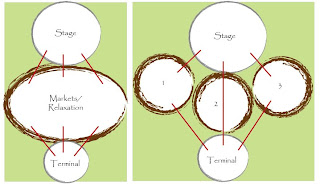After working on the previous design for a while now, I ended up reaching a dead end. I focused on so many different angular shapes, materials, structures, angles and heights. However, it was hard to blend that concept with my ferry terminal and bridge, nomatter what I tried to do with these two structures, no angular shape seemed worthy of changing the original design I had for them.
And unfortunately, I decided to go back to my curved structures. I miss the smooth and friendly curves, how easy they were on the eye and how they made me happy inside which I know they would make their users in real life. They weren't intimidating, they didn't cause one to stare, and as much as I wanted that, I don't think it is the approach my design needs, as much as I tried to force it to work, I kept seeing myself returning to the original design I had and trying to mimic it in a way. However, all hope is not gone, and all time is not wasted, we learn from our mistakes and it's time that I realised that my original way is the way I actually want it to be. This was an experiment which obviously disappointed me, and I'm gladly going back to the original!
However, not completely the original!
I had to venture through different programs trying to achieve the design I wanted, including AutoCad 3d, Revit, Rhino, Sketchup & Archicad. You will notice with a lot of my posts that they will be from numerous programs because of now, each one lacks a certain aspect that I need so I cant make up my mind in which one to stick with! :(
Through using the angular roofs, it made me realise that such long structures don't suit to act as one, but instead as their own structures in their own rights. Thats why I decided to change the long roof structure spanning a large distance, into segmented roofs which still connect evidently through their connection to the ground and the angles that they come back out of the ground from.
3d view of roof diappearing into the ground and back up again (Rhinoserous)
I also looked at the mushroom/umbrella roof I have and did some more research into it. A few examples are shown below, where I finally came to the design I'm satisfied with. Below are examples, sketches and drawings of the proposed stage roof.
Umbrella model and subdivisions
http://www.sciencedirect.com/science/article/pii/S0010448510002460
House of the risings suns - Metricon Stadium roof system
http://designbuildsource.com.au/house-rising-suns-metricon-stadium
Rosa Parks Transit Center roof system
http://criticaldetroit.org/buildings/rosa-parks-transit-center/
The main inspiration I got with the roofs above, is that they are there to leave an impression as one, serve a shading purpose, give a light feeling instead of large mass, and give the space a more organic atmosphere instead of the modern cube. Below is my interpretation of these within my space.
Simple section through stage & roof and ped/bike path
Roof Elevation
Section AA
Looking through section AA


















































